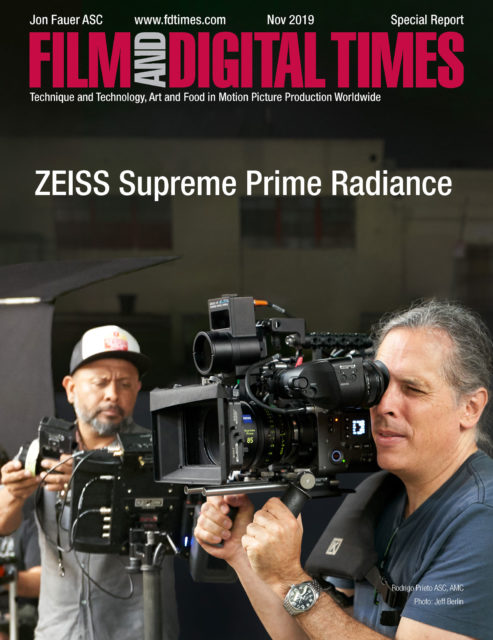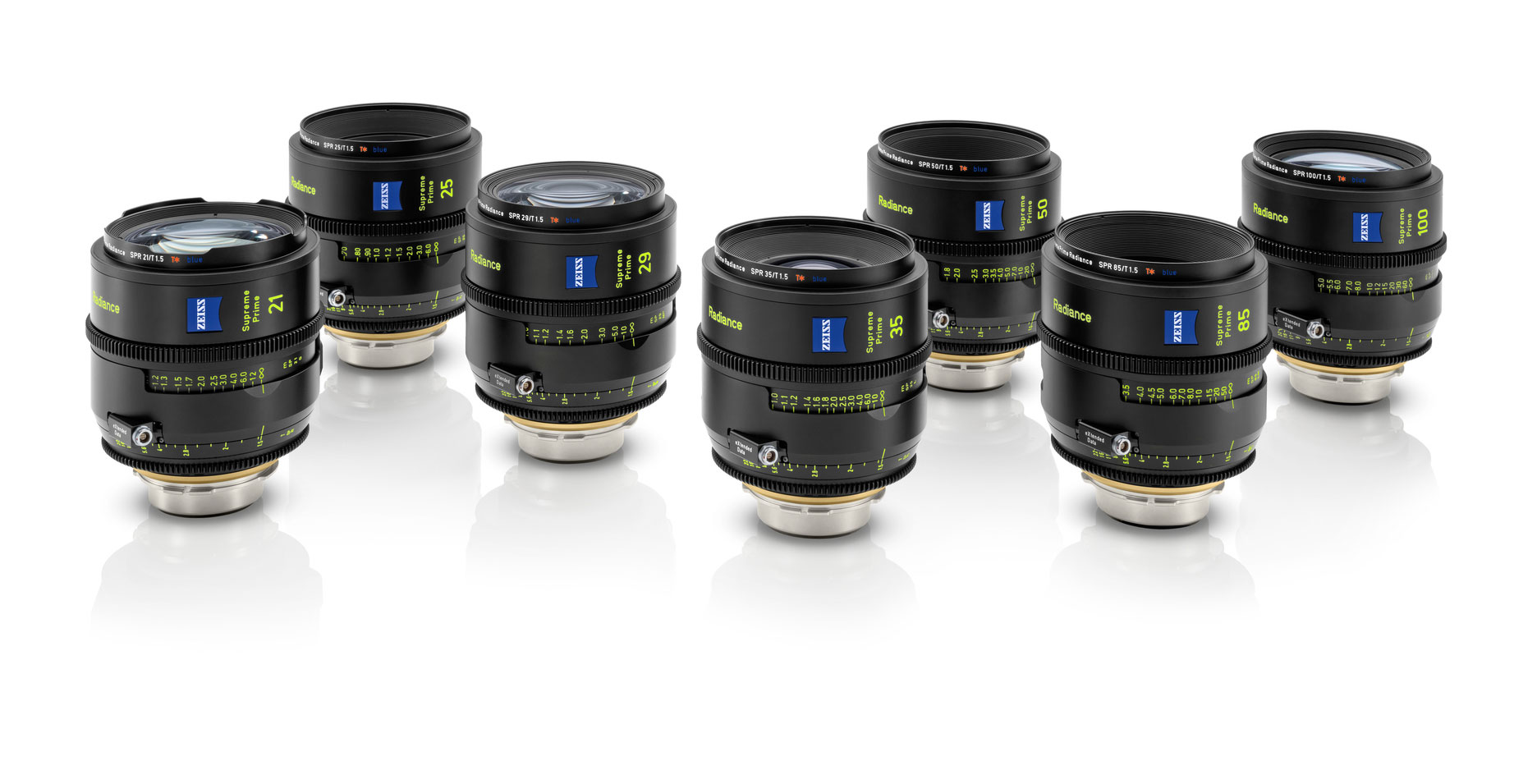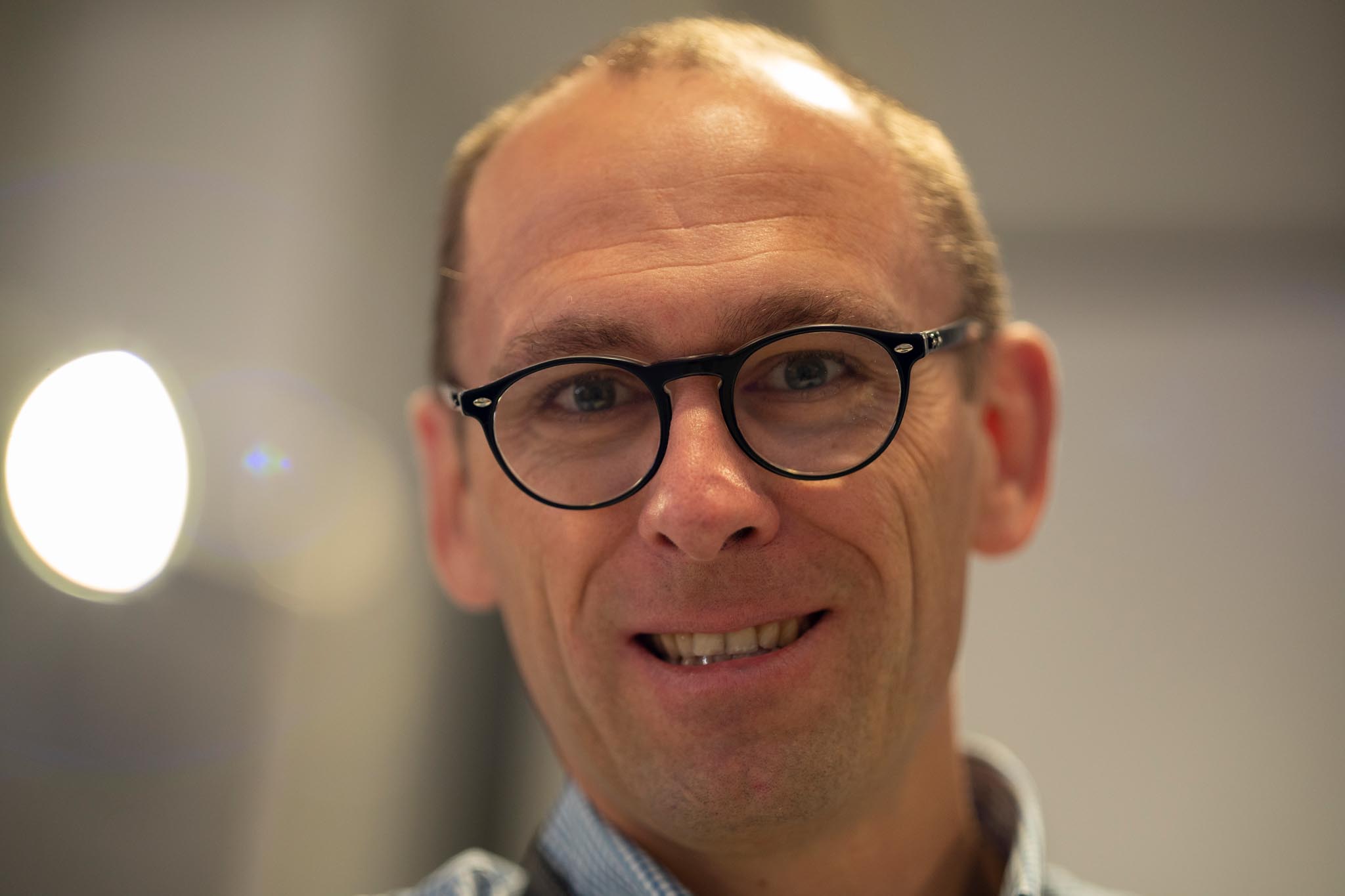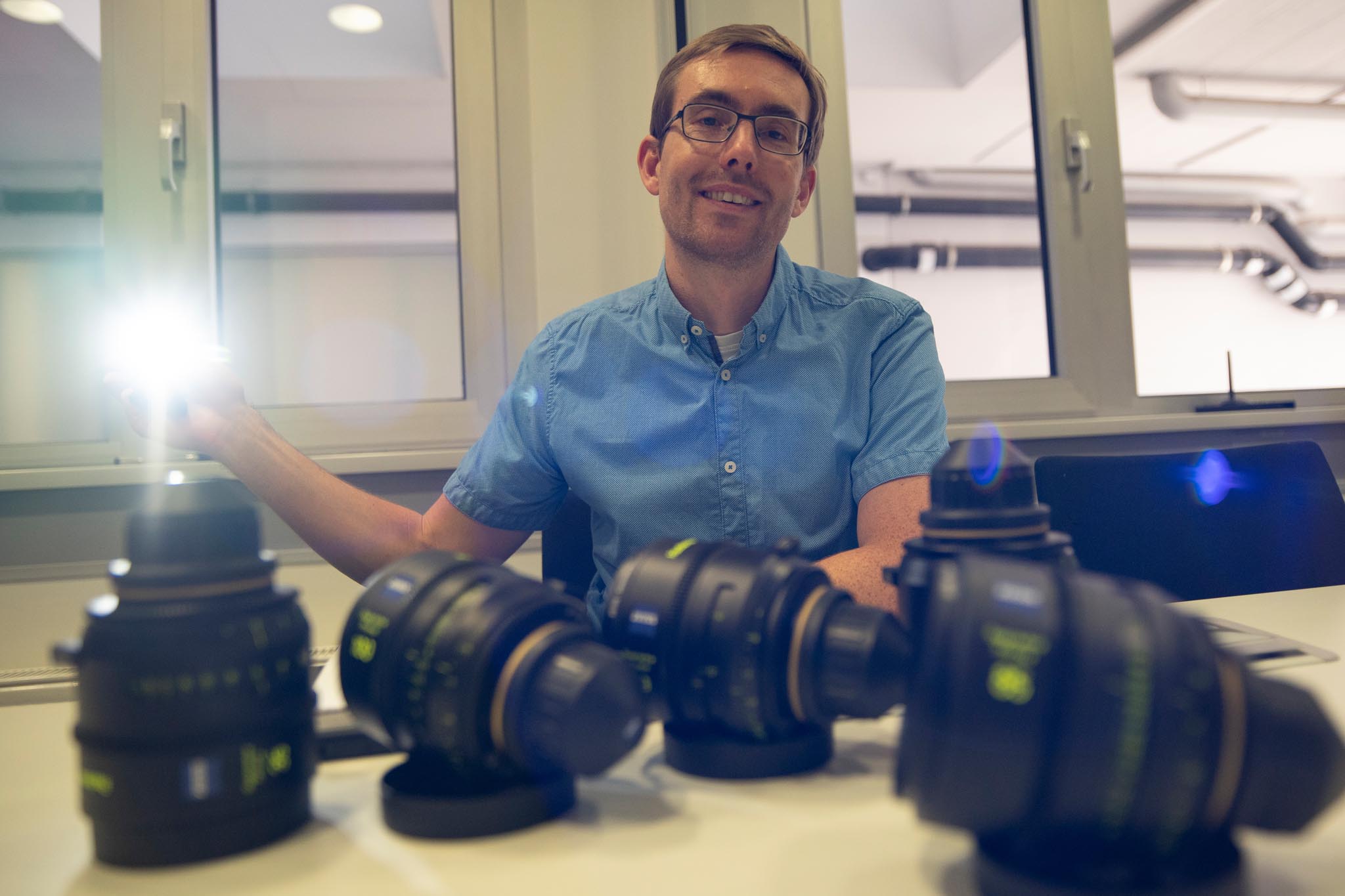ZEISS Supreme Prime Radiance lenses were announced November 7. Here’s a sneak preview of the cover story in the upcoming edition of FDTimes, issue 98, coming soon.
Download FDTimes 24-page PDF Special Report on ZEISS Supreme Prime Radiance lenses.
Excerpt from the SPR Report
Welcome to ZEISS headquarters in Oberkochen. We are talking with Christophe Casenave, Product Manager and Head of Sales for ZEISS Cinema Lenses and Dr. Benjamin Völker, ZEISS Optical Designer. The last time we spoke with Benjamin, he was busy removing ghosts and flares in the months leading up to the introduction of ZEISS Supreme Primes in June 2018. I called him Dr. Ghost Buster. He preferred Dr. Stray Light. This time, September 2019, he was busy introducing ghosts and flares into for a new series of lenses: ZEISS Supreme Prime Radiance. I now call him Dr. Ghost Provoker. Quick review: a ghost is a reflection between optical surfaces that shows up on the image. Flare is stray light on mechanical parts, as in internal barrel flare. We’ll get back to all that in a few minutes.
Jon Fauer: How did the concept for ZEISS Supreme Prime Radiance lenses begin?
Christophe Casenave: It goes back more than 7 years, when I first joined ZEISS. During that entire time, I always heard the same thing. Cinematographers and rental houses said, “Your lenses are superb but they lack character.” It was a constant barrage about this vague description of character. Then, when we introduced Supremes, some users said, “You are going in the right direction. They have a newfound character. They have a nice, gentle sharpness. You don’t need to de-tune them. But there’s something still missing. How do we flare them when we want to? Please give us even more flares (ghosts).”
Jon: What was your mandate, Benjamin…Dr. Ghost? What did was described as the things to do for these lenses?
Dr. Benjamin Völker: We had just finished working on the Supreme primes in April 2018. I remember Christophe came to me after he showed them to some rental houses and they asked for more ghosts.
Christophe: The same lenses, but with a bit more flare or ghosting. I thought we could do the same thing that we did in the past. Just put some uncoated surfaces on the front or rear element and we’ll have a flare set.
Benjamin: But I didn’t agree with that. From my perspective, one of worst things you can do in a situation like this is a flare set. First of all, when you’re confined to certain elements—front or rear—that you change, the shape of the ghost is fixed. And if you’re trying to uncoat the glass, the ghosts would be white. It will destroy your contrast and never truly achieve the results you want. It’s completely uncontrollable. You lose not only contrast but you also lose light. We had just finished designing excellent T1.5 Supremes. To then omit coatings on a few elements would result in losing a lot of light and all that nice contrast.
Christophe: So he didn’t want to do this. This is an important thing. He refused. What did we do then?
Benjamin: I heard there was a demand for vintage lenses. And I have to admit, I watch Netflix very often, like every evening. There are a number of productions that really use flares and ghosts heavily. I remember the new season of “Lost in Space” and several others. So, I was curious if we could do it in another way. Not the standard way by just omitting the coating. Most of all, I wanted to introduce ghosts in controllable shapes and colors and avoid the typical white haze and loss of light that results from omitting the coatings. Here in Oberkochen, we don’t have vintage lenses that are interesting to DPs. So, we came up with the idea of visiting rental houses in Paris and Hollywood.
Christophe: We flew to Los Angeles two days before Cine Gear. Keslow Camera kindly hosted us behind closed doors. They set up a big table with a huge inventory of all kinds of lenses. We discussed characteristics and they explained which were popular and why.
Benjamin: I knew that there was demand for certain lenses, but as a designer, I didn’t exactly know why. These were the questions we asked ourselves as we tested around 25 different lenses. They included K35, Baltar, Super Baltar Canon FD, Kowa anamorphic, Kowa spherical, ZEISS Super Speeds and a bunch of others. We shot for two 10-hour days. I set up a rig and we panned each lens aimed at light bulbs, LEDs and Neon signs. Ghosting depends a great deal on what light you use, at what position in the picture, how the background is illuminated and at what T-stop the lens is set. I got a feeling of what DPs maybe liked and what they did not like. We talked to DPs and staff working at the rental house. Then we returned back to Oberkochen. Going through all that footage was a very long and tedious process.
Christophe: I’d like to say that Benjamin worked the way a good product manager would work in any industry. Don’t ask the customer what they want and you do it. The customer would tell you, “I want uncoated lenses.” No. You ask the customer, “Tell me your problem, tell me what you want to achieve. And we will then work on the answer.” Benjamin truly provided something valuable that addresses the needs of the customer. He acted not only as a product manager, but also as an artist. He designed something beautiful.
Jon: How did you do it?
Benjamin: The basic idea we had was to add ghosts—controllable, but not too much. That’s really hard to achieve. Getting rid of ghosts completely is easy. Introducing them massively by doing uncoated elements is also easy, no work at all. But to find that certain level takes a lot of effort. And the other thing people always told us was they would prefer a bit of a warmer color rendering. So I tried to find a way to introduce all that at the same time and, of course, not to lose any light (because you lose about 1/3 of a T-Stop for every uncoated surface.)
Jon: Are all the elements treated this way?
Benjamin: No. We identified the surfaces that contribute the most to ghosting. A ghost originates from two surfaces. You change the coating on those two surfaces, but then the surfaces of all the other elements may be affected. The hard thing is to find the exact locations in the lens that are sensitive to the style that you want to add.
Jon: How did you get the color rendition warmer?
Benjamin: We developed a new T* (T-Star) Blue coating. It’s a new idea of introducing a coating into the lens that gives you bluish ghosts and at the same time gives you a warmer color rendering. If you take away blue light from the spectrum and use that for the ghosting, at the same time, your color rendering gets warmer. However, you have to be careful not to introduce a green or magenta color tint. Actually, it’s a bit more complicated than that. You are not only taking away the blue light, but you are also taking care of the rest of the spectrum so it is still balanced in such a way that you get a warmer look.
Jon: So if you see blue flares, that generally makes the picture warmer?
Benjamin: Not necessarily. It’s a combination of the light absorbed by the glass and the light reflected by the coatings.
Jon: Tell me again why did you not like the idea of flare sets?
Benjamin: It’s limited and you can only achieve rather vague shapes in the flares.
Christophe: The Radiance lenses are a first for ZEISS doing something like this. We wanted to change the opinion about ZEISS doing only perfect things. We wanted to make something artistic. So that’s why Benjamin had the possibility to exchange any lens elements he wanted, even to coat one surface with one recipe and another surface with another recipe.
Benjamin: Our idea was to find our own style. And it was only possible by having all the freedom that I was given.
Jon: How would you describe the style of these lenses to a DP?
Benjamin: The Supreme Prime Radiance lenses show a controllable blue-colored ghosting that will not destroy your contrast. Less contrast is lost than with a typical flare set. Radiance lenses are more versatile because you can use them throughout an entire production. If you don’t want flares, you can just flag the light. You still retain the slightly warmer color. You do not lose light. The maximum apertures of the Supremes and the Radiance are the same, T1.5.
Jon: You and I both like wine analogies. How would you compare the regular Supremes to the Radiance?
Christophe: If we would have done completely uncoated elements, I would say we would have gone to a Saint-Estèphe, or perhaps Saint-Julien, on the left side of the Garonne estuary north of Bordeaux. Quite heavy. But for the Radiance primes, we have a comparison that fits quite well to my preferred wine.
Jon: How convenient.
Christophe: I would say it is a very good Pessac-Léognan, from the northern part of the Graves region. When you go to this side of Bordeaux, the terroir is a mix of sand and gravel of round stones.
Jon (reading aloud) “Famous chateaux in the Pessac-Léognan region include Smith Haut Lafitte, Château Haut-Bailly and Château Haut-Brion (Premier Grand Cru Classé.) Eric Asimov writes in the New York Times, “Fresh and lively, with pretty aromas and flavors of violets, red fruits, spices and minerals.” Wine Spectator says, “Lush, rich, glorious and beautifully polished.” Robert Parker agrees, “profound and arresting, a firm frame of very finely pixelated tannins and seamless freshness, finishing very long and achingly stunning.”
Christophe: We all agree. Maybe we’ll have one tonight.
Jon: It is ironic that in talking about vintage lenses, we often think of the 1960s, 70s and 80s. But those lenses all had AR coatings. The uncoated lenses date back to the 1930s and earlier and the reason DPs avoided flares was because the image would often go to total white-out.
Benjamin: That was exactly the idea behind developing our new coating that resembles mostly the possibilities you had in the sixties, seventies or eighties.
Christophe: Let’s take the ZEISS Super Speeds. They were originally made at a time (1975) where you could only do a single layer coating. That’s a reason why they are often called “vintage.”
Jon: Or maybe because of their weird triangular bokeh? Super Speeds are now cherished as vintage lenses. I owned a set with my 35BL and in those days they were considered clinical.
Christophe: If you would ask my retired colleague Helmut, he would immediately tell you that those lenses are not vintage. He would say. “Put them on a projection. You see they are very sharp.” But now people like them. They are softer at T1.3 or T1.4. But as soon as we stop down to T2.8, they are very sharp and the depth of field helps the focus. These days, people love the Super Speeds. And now, 44 years later, Benjamin has the possibility to play with old style and modern coatings with many more recipes. This is art and technology.
Jon: The Super Speeds were sharp at the focus plane, the eye of the actor. And everything else not in focus fell off a cliff. Very contrasty, rich blacks. Not romantic. So why do we call them vintage now?
Christophe: Well, the mechanics are certainly vintage and that is one of the issues about vintage lenses. The whole lens is vintage. The mechanical parts are old. The focus and iris mechanism are old. They can break on set. Not the Super Speeds, of course. They will not break on set.
Benjamin: Because they are ZEISS. [laughs]
Christophe: If you look at what’s available, there are different choices to add character. Take a vintage lens. Sometimes they are very nice and the ghosts might even be on the same level as Radiance lenses. But you cannot control or match them as well. You have all the drawbacks of vintage mechanical design. Take the Super Speeds. They are really small but they don’t have great ergonomics. Or Super Baltars: you never know when you start shooting if at the end of the shoot they will still be working because they are quite old. The K35 are also rather old lenses and unless you rehouse them, it’s a risk for the DP. So we wanted to offer DPs a way to bring character to their productions without their having to take a risk.
There’s another consideration. A select group of top DPs are confident enough to experiment and not worry about job security on features. And maybe no one will fire them if they mess up a shot because a ghost obscures the face of an actor whom the producer has paid 40 million dollars. These are typically the DPs who like to step on the hornets’ nests of really sketchy glass. Commercials seem more open to creative abandon. But let’s say that the remaining population of cinematographers need to work reliably and consistently and not tempt fate with reshoots. So the way they do it today is to take a reliable favorite, perhaps a Master Prime or Supreme Prime and put the “last mile of character in the image” either in post or with lighting or filters. The images will be nice.
Now, we are presenting a new series of lenses, the Supreme Prime Radiance, where DPs can add character to their images, with consistent and controlled ghosts, without fear of uncontrolled aberrations or controlled retribution from irate producers. That’s how the idea came about. How we implemented it is another story. Benjamin will tell you about it because it’s something that ZEISS almost never did before in response to what customers told us.
Benjamin: It was really like picking the elements we wanted to ghost and putting a specialty coating on them while adding strong anti-reflective coatings on the surfaces that we didn’t want to have ghosts. Furthermore, we treated the Radiance primes as a family. They needed to have very similar ghosting for all focal lengths. That was actually one of the hardest parts of the job: to achieve a comparable level so the ghosting behavior of a 100mm tele lens would be the same as a 21mm wide angle.
Jon: So you had to coat different elements in each lens to keep them consistent?
Benjamin: We had to develop that idea—how many elements in front of the iris, how many in the rear part, where do we position the ghosts exactly? What recipe do we use to get the color rendering to match across the whole family?
Jon: You call them ghosts and we DPs call them flares. We talked about that last year. Please explain it again.
Benjamin: For me, a ghost is a reflection between two optical surfaces that gives you a more or less sharp image of that reflection on the image sensor. Flare for me is more like stray light on mechanical parts like the inside of the lens barrel. I know that we use these words almost interchangeably among DPs and developers and we are not even consistent.
Jon: Last year, when you discussed the Supremes, I called you Dr. Ghost Buster. Now, with the Radiance primes, I think you are the Ghost Whisperer.
Christophe: I would a say he’s a Ghost Painter. He’s an artist. A Ghost Provocateur.
Jon: A Ghost Writer. A Writer with Flair. A Writer of Flares. So why is it that we DPs say that flares or ghosts add character? Is there something else that we are responding to when we say a lens has character? You gentlemen looked at a lot of lenses. What did you discover after your two days at the rental house? What is character?
Benjamin: It is, in some way, a kind of imperfection that you introduce so that your image is not clinically clean and you have to interpret imperfections that add emotion to the image.
Christophe: Let’s say I am sitting in the front row of the cinema and I’m watching the images on screen. I don’t want to see the same reality that I can see outside the theater. I do not want to see images so perfect that I would bump into the screen if I walked on stage. As a spectator, I think we appreciate everything that helps us consciously or unconsciously to step away from reality. A ghost from the lens is really a part of that disconnect from reality. As soon as I see a ghost, I say it has been painted by someone. It’s not part of the reality.
Jon: I’m reminded of Claude’s “Seaport” (1644, National Gallery, London.) The sun is setting and the light flares off the water.
Benjamin: You can use ghosts as a stylistic element. If you have a really bright light source and you film it, often that light source clips. You don’t really have a perception of how bright it actually is because of the sensor’s limitations. But with a ghost, you get a feeling that this light source is really bright.
Jon: I can imagine, as soon as the Radiance go out, customers may ask if they can customize them? Because every DP and every rental house wants to be unique.
Christophe: I think we need to find a very good balance between introducing character and allowing the DP to still have possibilities of bringing additional interest with other elements like using filters. I remember testing the Supremes last year in Paris with Samuel Renollet of RVZ and Yves Angelo AFC, SBC. He talked about making his own filters 30 years ago. He kept them in a custom wooden box. “You know you can only do this kind of thing if the lens is sharp enough,” he said. “Otherwise, you can’t really adjust anything.”
I think we can offer a certain level of character you can’t produce by just doing filtering or lighting differently. First we should provoke the ghosts. And then we can use the right lighting, the right filters, to achieve the other looks. I think that was more or less why we did the lenses like this.
Jon: I’m sure you experimented with the Radiance lenses a lot. Can you give us a lesson as to what the different things we can do by shining a light off access, on access, flagging it off, keeping flares out? What are the different possibilities that we have with this set of lenses?
Benjamin: If you want to increase the ghosting, bring the light source to the center. The further you move from center to the edge of frame, or even outside of frame, the ghosting will diminish, but it will not completely vanish. If you’re outside the field of view, there’s an area where you still get a controllable ghosting within the frame. And if you want to get more pronounced ghosting, then begin stopping down. The ghosting will become more structured once you stop down. And it becomes a bit softer when you open the iris up completely.
Jon: It sounds like you put in a lot of work and effort into the Radiance primes.
Christophe: Benjamin told you his side of the story: how he designed the lenses. Now, I will tell my side of the story. For me, it was scary, and I don’t mean Halloween style ghosts. Benjamin was super happy, having a great time designing ghosts. He worked very hard, with very long hours. How many simulations did you do?
Benjamin: Many, many hundreds of hours of simulations.
Christophe: There were hundreds of simulation pictures. And then he would ask me, “Which do you prefer?” We would pick a few. Next, Benjamin would say, “But I can’t guarantee this quite yet, and I’m not sure about the intensity.” We were watching images of ghosts all the time. I would get home in the evening and when I closed my eyes I saw nothing but ghosts. And then the time came to make choices based on computer simulations. And Benjamin said, “My simulation program is rather good. But perhaps we should purchase a lot of different lens elements and test with real prototypes.”
So we ordered three or four versions of each lens element for each focal length and coated them in different ways. Benjamin had pre-calculated his preferred version but there were many variations. It was like going to the optometrist where they flip various combinations of lenses in front of you. We basically ordered a hell of a lot of glass elements. To be honest, this was damned expensive. Uniquely made glass elements with special coatings took us at least four months. And then some of our favorite choices for some focal lengths turned out not to match others. So we needed to change. It was more than six months of trying, experimenting, deciding and then oops, back to the drawing board because we may have made the wrong decision. It was really something we were not used to. Normally we design the lenses, the simulations are solid, we build the lenses and it’s done.
Benjamin: The point is there’s only so much you can do in simulation. But you cannot describe every possibility in simulation. This was also the first time for me to spend so much time in the lab to actually measure every prototype and try it out under all the different lighting conditions.
Christophe: I would like to mention the fact that we have a whole bunch of lens elements that we never used. More than 500. So if anyone wants, maybe we should sell them. No, but seriously, this was so much fun. We would meet in the basement at ZEISS with flashlights shining in the lenses the way DPs do.
Benjamin: I think it was totally worth it because otherwise we wouldn’t have found that style.
Christophe: This was a very rewarding experience and we look forward to sharing our excitement with cinematographers and customers everywhere.
It was 6 pm. We packed up the Supreme Prime Radiance lenses and cameras into shoulder bags and piled into Christophe’s car for an evening of testing and tasting at the Michelin-starred Ursprung Restaurant. 15 minutes later, we arrived in the charming village of Zang. Chef Widmann and staff were extremely patient as we provoked radiant ghosts upon every dish their tasting menu offered.
Videos on ZEISS Supreme Prime Radiance
https://youtu.be/jAuXgazw2p4
Download FDTimes 24-page PDF Special Report on ZEISS Supreme Prime Radiance lenses.












